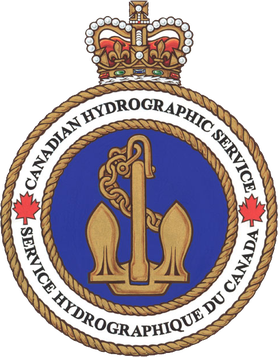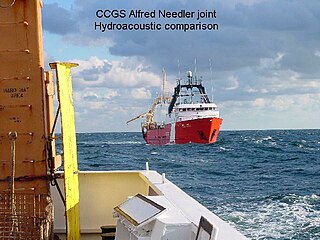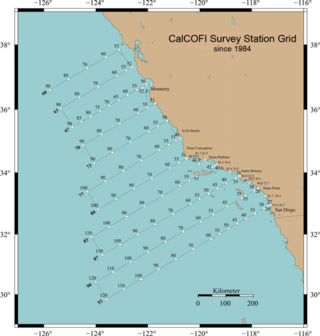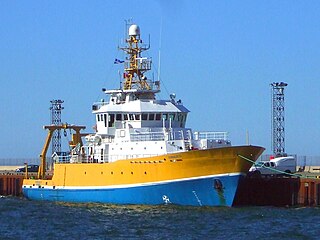Related Research Articles

The Gulf of St. Lawrence fringes the shores of the provinces of Quebec, New Brunswick, Nova Scotia, Prince Edward Island, Newfoundland and Labrador, in Canada, plus the islands Saint-Pierre and Miquelon, possessions of France, in North America.

The Canadian Coast Guard is the coast guard of Canada. Formed in 1962, the coast guard is tasked with marine search and rescue (SAR), communication, navigation, and transportation issues in Canadian waters, such as navigation aids and icebreaking, marine pollution response, and support for other Canadian government initiatives. The Coast Guard operates 119 vessels of varying sizes and 23 helicopters, along with a variety of smaller craft. The CCG is headquartered in Ottawa, Ontario, and is a special operating agency within Fisheries and Oceans Canada.

The Canadian Hydrographic Service (CHS) is part of the federal department of Fisheries and Oceans Canada and is Canada's authoritative hydrographic office. The CHS represents Canada in the International Hydrographic Organization (IHO).

The Bedford Institute of Oceanography (BIO) is a major Government of Canada ocean research facility located in Dartmouth, Nova Scotia. BIO is the largest ocean research station in Canada. Established in 1962 as Canada's first, and currently largest, federal centre for oceanographic research, BIO derives its name from the Bedford Basin, an inland bay comprising the northern part of Halifax Harbour, upon which it is located.

The Université du Québec à Rimouski is a public university located in Rimouski, Quebec, Canada with a campus in Lévis.

CCGS Alfred Needler is an offshore fishery science vessel formerly operated by the Canadian Coast Guard. The vessel entered service in 1982 with the Department of Fisheries and Oceans, stationed at the Bedford Institute of Oceanography in Dartmouth, Nova Scotia. In 1995, in order to reduce the number of ships and combine tasks, the Fisheries and Oceans fleet and the Canadian Coast Guard fleets were merged under the Canadian Coast Guard. The ship was decommissioned from Canadian Coast Guard service in 2023.

Pukyong National University is a national university in Busan, South Korea, formed in 1996. The university has two campuses, Daeyeon-dong and Yongdang-dong, situated near the coastal district of Nam-gu. PKNU has a traditional focus on fisheries sciences and other maritime fields, and has extensive facilities for Marine and Technology studies.

Aquarium du Québec is a public aquarium located in the former city of Sainte-Foy in Quebec City, Quebec, Canada. The 16-hectare (40-acre) facility is home to more than 10,000 animals representing more than 300 species. It is operated by Société des établissements de plein air du Québec (Sépaq), and is a member of the Canadian Association of Zoos and Aquariums (CAZA).

The South African Institute for Aquatic Biodiversity (SAIAB), is involved in research, education and in applications of its knowledge and research to African fish fauna, for either economic or conservation benefit.

CalCOFI is a multi-agency partnership formed in 1949 to investigate the collapse of the sardine population off California. The organization's members are from NOAA Fisheries Service, Scripps Institution of Oceanography, and California Department of Fish and Wildlife. The scope of this research has evolved into the study of marine ecosystems off California and the management of its fisheries resources. In 2004, the CalCOFI survey area became one of 26 Long Term Ecological Research Network (LTER) research sites. This time-series of oceanographic and fisheries data allows scientists to assess the human impact and effects of climate change on the coastal ocean ecosystem. CalCOFI hydrographic and biological data, publications, and web information are distributed for use without restriction under the terms of the GNU Free Documentation License.

Coriolis II is a Canadian research vessel. She is homeported in Rimouski, Quebec. She is operated by a consortium of five institutions: Institut des sciences de la mer à Rimouski (ISMER), the Université du Québec à Montréal (UQAM), McGill University, the Institut national de la recherche scientifique - Eau, terre et environnement (INRS-ETE) and the Maurice Lamontagne Institute (MLI-DFO). The vessel was constructed in 1990 by Versatile Pacific Shipyards of Esquimalt, British Columbia for the Canadian Coast Guard. Initially named CCGS John Jacobson, the vessel was deployed for search and rescue missions along Canada's coastlines. The Canadian Coast Guard took John Jacobson out of service in 1999 and sold the ship to her current owners in 2001.

The Virginia Institute of Marine Science (VIMS) is one of the largest marine research and education centers in the United States. Founded in 1940, VIMS is unique among marine science institutions in its legal mandate to provide research, education, and advisory services to government, citizens, and industry. Funding for VIMS comes from the Commonwealth of Virginia, grants and contracts from federal and state agencies, and private giving. The School of Marine Science (SMS) at VIMS is the graduate school in marine science for the College of William & Mary. VIMS offers M.S., Ph.D., and professional M.A. degrees in marine science. The school has 52 faculty members, an enrollment of 80-100 students, and includes 4 academic departments. VIMS' main campus is located in Gloucester Point, Virginia.

The Institute of Ocean Sciences is operated by Fisheries and Oceans Canada and is one of the largest marine research centres in Canada. It is located on Patricia Bay and the former British Columbia Highway 17A in Sidney, British Columbia on Vancouver Island just west of Victoria International Airport.
St. Andrews Biological Station is a Fisheries and Oceans Canada research centre located on Brandy Cove Road in St. Andrews, New Brunswick.

The Pacific Biological Station is a Research station in Departure Bay, Nanaimo, British Columbia, Canada. Established in 1908, with the Rev. George William Taylor as its first director and sole employee, it is the oldest fisheries research centre on the Pacific coast. Operated by Fisheries and Oceans Canada, the station forms a network with eight other scientific facilities.
Narayana Balakrishnan Nair (1927–2010) was a marine biologist, ecologist and the founder president of Kerala Science Congress. He was known for his advocacy of trawling ban during monsoon seasons which was later accepted and imposed by the Government of Kerala. A Jawaharlal Nehru fellow, Nair was an elected fellow of all the major Indian science academies as well as the Zoological Society of London. The Council of Scientific and Industrial Research, the apex agency of the Government of India for scientific research, awarded him the Shanti Swarup Bhatnagar Prize for Science and Technology, one of the highest Indian science awards, in 1971, for his contributions to biological sciences. He received the fourth highest Indian civilian honor of the Padma Shri in 1984.
The UBC Institute for the Oceans and Fisheries (IOF) is a research unit at the University of British Columbia (UBC) that was formed in 2015 by incorporating members from the former UBC Fisheries Centre, as well as a subset of researchers that are conducting marine related research at UBC. The IOF developed its own graduate program, which welcomed its first cohort of graduate students in September 2019. In addition to students of its OCF program, members are also drawn from other graduate programs at UBC, primarily from the Institute for Resources, Environment and Sustainability, the Departments of Earth, Ocean and Atmospheric Sciences, Zoology, Geography, and Botany, and the School of Public Policy and Global Affairs. The UBC Institute for the Oceans and Fisheries brings together a community of Canadian and international experts in ocean and freshwater species, systems, economics, and issues to provide new insights into how global marine systems function, and the impacts of human activity on those systems. It is working towards a world in which the oceans are healthy and their resources are used sustainably and equitably. IOF is located at The University of British Columbia, and promotes multidisciplinary study of aquatic ecosystems and broad-based collaboration with researchers, educators, maritime communities, government, NGOs, and other partners.

St. Lawrence Estuary stretches from west to east for 655 km, from the outlet of Lake Saint Pierre to Pointe-des-Monts, where it becomes the Gulf of St. Lawrence, in Quebec, Canada.
References
- 1 2 3 Department of Fisheries and Oceans Canada - Maurice Lamontagne Institute Library, Librarything.com
- 1 2 3 Maurice Lamontagne Institute, Fisheries and Oceans Canada, Quebec Region, Canada.ca, 9 June 2017